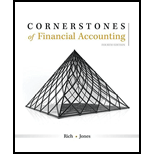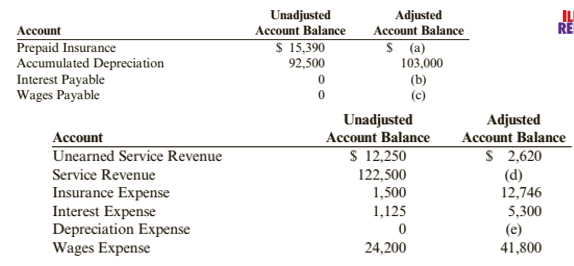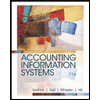
Cornerstones of Financial Accounting
4th Edition
ISBN: 9781337690881
Author: Jay Rich, Jeff Jones
Publisher: Cengage Learning
expand_more
expand_more
format_list_bulleted
Concept explainers
Textbook Question
Chapter 3, Problem 68BPSB
Problem 3-68B Inferring
The following schedule shows all the accounts of Eagle Imports that received year end adjusting entries:

Required:
- Calculate the missing amounts identified by the letters (a) through (e).
- Prepare the five adjusting entries that must have been made to cause the account changes as indicated.
Expert Solution & Answer
Want to see the full answer?
Check out a sample textbook solution
Students have asked these similar questions
Summit Mechanical Co. has a normal capacity of 25,000 direct labor hours. The company's variable costs are $32,500, and its fixed costs are $18,750 when operating at normal capacity. What is its standard manufacturing overhead rate per unit?
hello teacher please solve questions
Opereting leverage?
Chapter 3 Solutions
Cornerstones of Financial Accounting
Ch. 3 - How does accural-basis net income differ from...Ch. 3 - Explain when revenue may be recognized and give an...Ch. 3 - What happens during the accounting cycle?Ch. 3 - Prob. 4DQCh. 3 - Why are adjusting entries needed?Ch. 3 - What accounting concepts require that adjusting...Ch. 3 - Prob. 7DQCh. 3 - Prob. 8DQCh. 3 - What is the difference between an accural and a...Ch. 3 - Prob. 10DQ
Ch. 3 - Prob. 11DQCh. 3 - Describe the effect on the financial statements...Ch. 3 - Prob. 13DQCh. 3 - Prob. 14DQCh. 3 - Prob. 15DQCh. 3 - Prob. 16DQCh. 3 - Prob. 17DQCh. 3 - Prob. 18DQCh. 3 - ( Appendix 3A) What is the relationship between...Ch. 3 - Prob. 20DQCh. 3 - Which of the following statements is true? Under...Ch. 3 - In December 2019, Swanstrom Inc. receives a cash...Ch. 3 - Which transaction would require adjustment at...Ch. 3 - Which of the following statements is false?...Ch. 3 - Dallas Company loaned to Ewing Company on December...Ch. 3 - Rons Diner received the following bills for...Ch. 3 - In September 2019, GolfWorld Magazine obtained...Ch. 3 - Hurd Inc. prepays rent every 3 months on March 1,...Ch. 3 - Which of the following statements is incorrect...Ch. 3 - Reinhardt Company reported revenues of $122,000...Ch. 3 - Prob. 11MCQCh. 3 - Cornerstone Exercise 3-12 Accrual- and Cash-Basis...Ch. 3 - Cornerstone Exercise 3-13 Accrual- and Cash-Basis...Ch. 3 - Prob. 14CECh. 3 - Prob. 15CECh. 3 - Cornerstone Exercise 3-16 Identification of...Ch. 3 - Cornerstone Exercise 3-17 Accrued Revenue...Ch. 3 - Cornerstone Exercise 3-18 Accrued Expense...Ch. 3 - Cornerstone Exercise 3-19 Deferred Revenue...Ch. 3 - Cornerstone Exercise 3-20 Deferred Expense...Ch. 3 - Cornerstone Exercise 3-21 Adjustment for Supplies...Ch. 3 - Cornerstone Exercise 3-22 Adjustment for...Ch. 3 - Prob. 23CECh. 3 - Cornerstone Exercise 3-24 Preparing an Income...Ch. 3 - Cornerstone Exercise 3-25 Preparing a Retained...Ch. 3 - Cornerstone Exercise 3-26 Preparing a Balance...Ch. 3 - Cornerstone Exercise 3-27 Preparing and Analyzing...Ch. 3 - Brief Exercise 3-28 Accrual- and Cash-Basis...Ch. 3 - Brief Exercise 3-29 Revenue and Expense...Ch. 3 - Brief Exercise 3-30 Identification of Adjusting...Ch. 3 - Brief Exercise 3-31 Adjusting Entries-Accruals...Ch. 3 - Brief Exercise 3-32 Adjusting Entries-Deferrals...Ch. 3 - Brief Exercise 3-33 Preparing an Income Statement...Ch. 3 - Brief Exercise 3-34 Preparing a Retained Earnings...Ch. 3 - Prob. 35BECh. 3 - Brief Exercise 3-36 Preparing and Analyzing...Ch. 3 - Prob. 37BECh. 3 - Exercise 3-38 Accrual- and Cash-Basis Expense...Ch. 3 - Exercise 3-39 Revenue Recognition Each of the...Ch. 3 - Exercise 3-40 Revenue and Expense Recognition...Ch. 3 - Exercise 3-41 Cash-Basis and Accrual-Basis...Ch. 3 - Exercise 3-42 Revenue and Expense Recognition...Ch. 3 - Exercise 3-43 Recognizing Expenses Treadway Dental...Ch. 3 - Exercise 3-44 Revenue Expense and Recognition...Ch. 3 - Exercise 3-45 Identification of Adjusting Entries...Ch. 3 - Exercise 3-46 Identification and Analysis of...Ch. 3 - Exercise 3-47 Revenue Adjustments Sentry Transport...Ch. 3 - Expense Adjustments Faraday Electronic Service...Ch. 3 - Prob. 49ECh. 3 - Exercise 3-50 Prepayment of Expenses JDM Inc. made...Ch. 3 - Exercise 3-51 Adjustment for Supplies The downtown...Ch. 3 - Adjusting Entries Exercise 3-52 Allentown Services...Ch. 3 - Prob. 53ECh. 3 - Exercise 3-54 Recreating Adjusting Entries...Ch. 3 - Exercise 3-55 Effect of Adjustments on the...Ch. 3 - Exercise 3-56 Preparing an Income Statement Oxmoor...Ch. 3 - Exercise 3-57 Preparing a Retained Earnings...Ch. 3 - Exercise 3-58 Preparing a Balance Sheet Refer to...Ch. 3 - Exercise 3-59 Preparation of Closing Entries Grand...Ch. 3 - Exercise 3-60 Preparation of Closing Entries James...Ch. 3 - Exercise 3-61 Preparation of a Worksheet (Appendix...Ch. 3 - Problem 3-62A Cash-Basis and Accrual-Basis Income...Ch. 3 - Problem 3-63A Revenue and Expense Recognition...Ch. 3 - Problem 3-64A Identification and Preparation of...Ch. 3 - Problem 3-65A Preparation of Adjusting Entries...Ch. 3 - Problem 3-66A Effects of Adjusting Entries on the...Ch. 3 - Problem 3-67A Adjusting Entries and Financial...Ch. 3 - Problem 3-68A Inferring Adjusting Entries from...Ch. 3 - Problem 3-69A Preparation of Closing Entries and...Ch. 3 - Problem 3-70B Comprehensive Problem: Reviewing the...Ch. 3 - Problem 3-71 A Preparing a Worksheet (Appendix 3A)...Ch. 3 - Prob. 62BPSBCh. 3 - Problem 3-63B Revenue and Expense Recognition Aunt...Ch. 3 - Problem 3-64B Identification and Preparation of...Ch. 3 - Problem 3-65B Preparation of Adjusting Entries...Ch. 3 - Problem 3-66A Effects of Adjusting Entries on the...Ch. 3 - Problem 3-67B Adjusting Entries and Financial...Ch. 3 - Problem 3-68B Inferring Adjusting Entries from...Ch. 3 - Problem 3-69B Preparation of Closing Entries and...Ch. 3 - Problem 3-70B Comprehensive Problem: Reviewing the...Ch. 3 - Problem 3-71B Preparing a Worksheet (Appendix 3A)...Ch. 3 - Case 3-72 Cash- or Accrual-Basis Accounting Karen...Ch. 3 - Case 3-73 Recognition of Service Contract Revenue...Ch. 3 - Case 3-73 Recognition of Service Contract Revenue...Ch. 3 - Case 3-73 Recognition of Service Contract Revenue...Ch. 3 - Case 3-74 Revenue Recognition Melaney Parks...Ch. 3 - Prob. 74.2CCh. 3 - Prob. 75CCh. 3 - Prob. 76CCh. 3 - Prob. 77.1CCh. 3 - Prob. 77.2CCh. 3 - Prob. 78.1CCh. 3 - Prob. 78.2CCh. 3 - Case 3-78 Interpreting Closing Entries Barnes...Ch. 3 - Case 3-79 Research and Analysis Using the Annual...Ch. 3 - Prob. 79.2CCh. 3 - Prob. 79.3CCh. 3 - Prob. 79.4CCh. 3 - Prob. 79.5CCh. 3 - Prob. 80.1CCh. 3 - Refer to the 10-K reports of Under Armour, Inc.,...Ch. 3 - Prob. 80.3CCh. 3 - Prob. 80.4CCh. 3 - Prob. 81.1CCh. 3 - Prob. 81.2CCh. 3 - Prob. 81.3CCh. 3 - Prob. 81.4CCh. 3 - Prob. 81.5CCh. 3 - Prob. 81.6CCh. 3 - Prob. 81.7C
Knowledge Booster
Learn more about
Need a deep-dive on the concept behind this application? Look no further. Learn more about this topic, accounting and related others by exploring similar questions and additional content below.Similar questions
- Suppose Loc Motors, Inc. has 720 million shares outstanding with a share price of $65.20, and $30.85 billion in debt. If in three years, Loc Motors has 770 million shares outstanding trading for $78.45 per share, how much debt will Loc Motors have if it maintains a constant debt-equity ratio? The amount of debt required in three years will be $_ billion. Accounting problemarrow_forwardGeneral Accountingarrow_forwardWhat was the net income for the year?arrow_forward
- Suppose Loc Motors, Inc. has 720 million shares outstanding with a share price of $65.20, and $30.85 billion in debt. If in three years, Loc Motors has 770 million shares outstanding trading for $78.45 per share, how much debt will Loc Motors have if it maintains a constant debt-equity ratio? The amount of debt required in three years will be $_ billion.arrow_forward!??arrow_forwardhi expert please help me general accountarrow_forward
- Suppose Loc Motors, Inc. has 720 million shares outstanding with a share price of $65.20, and $30.85 billion in debt. If in three years, Loc Motors has 770 million shares outstanding trading for $78.45 per share, how much debt will Loc Motors have if it maintains a constant debt-equity ratio? The amount of debt required in three years will be $_ billion. Need answerarrow_forwardPlease give me answer general accounting questionarrow_forwardFinancial Accounting Question need help pleasearrow_forward
arrow_back_ios
SEE MORE QUESTIONS
arrow_forward_ios
Recommended textbooks for you
 Financial AccountingAccountingISBN:9781337272124Author:Carl Warren, James M. Reeve, Jonathan DuchacPublisher:Cengage Learning
Financial AccountingAccountingISBN:9781337272124Author:Carl Warren, James M. Reeve, Jonathan DuchacPublisher:Cengage Learning College Accounting, Chapters 1-27AccountingISBN:9781337794756Author:HEINTZ, James A.Publisher:Cengage Learning,
College Accounting, Chapters 1-27AccountingISBN:9781337794756Author:HEINTZ, James A.Publisher:Cengage Learning, Accounting (Text Only)AccountingISBN:9781285743615Author:Carl Warren, James M. Reeve, Jonathan DuchacPublisher:Cengage Learning
Accounting (Text Only)AccountingISBN:9781285743615Author:Carl Warren, James M. Reeve, Jonathan DuchacPublisher:Cengage Learning Financial And Managerial AccountingAccountingISBN:9781337902663Author:WARREN, Carl S.Publisher:Cengage Learning,
Financial And Managerial AccountingAccountingISBN:9781337902663Author:WARREN, Carl S.Publisher:Cengage Learning, Accounting Information SystemsFinanceISBN:9781337552127Author:Ulric J. Gelinas, Richard B. Dull, Patrick Wheeler, Mary Callahan HillPublisher:Cengage LearningCentury 21 Accounting Multicolumn JournalAccountingISBN:9781337679503Author:GilbertsonPublisher:Cengage
Accounting Information SystemsFinanceISBN:9781337552127Author:Ulric J. Gelinas, Richard B. Dull, Patrick Wheeler, Mary Callahan HillPublisher:Cengage LearningCentury 21 Accounting Multicolumn JournalAccountingISBN:9781337679503Author:GilbertsonPublisher:Cengage

Financial Accounting
Accounting
ISBN:9781337272124
Author:Carl Warren, James M. Reeve, Jonathan Duchac
Publisher:Cengage Learning

College Accounting, Chapters 1-27
Accounting
ISBN:9781337794756
Author:HEINTZ, James A.
Publisher:Cengage Learning,

Accounting (Text Only)
Accounting
ISBN:9781285743615
Author:Carl Warren, James M. Reeve, Jonathan Duchac
Publisher:Cengage Learning

Financial And Managerial Accounting
Accounting
ISBN:9781337902663
Author:WARREN, Carl S.
Publisher:Cengage Learning,

Accounting Information Systems
Finance
ISBN:9781337552127
Author:Ulric J. Gelinas, Richard B. Dull, Patrick Wheeler, Mary Callahan Hill
Publisher:Cengage Learning

Century 21 Accounting Multicolumn Journal
Accounting
ISBN:9781337679503
Author:Gilbertson
Publisher:Cengage
The accounting cycle; Author: Alanis Business academy;https://www.youtube.com/watch?v=XTspj8CtzPk;License: Standard YouTube License, CC-BY